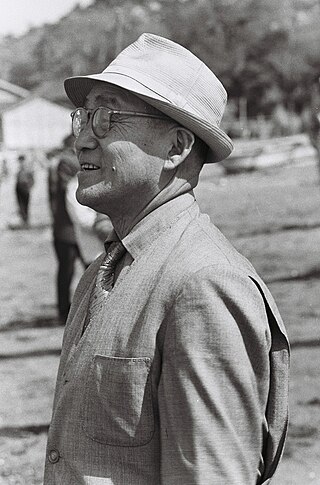
Eiji Tsuburaya was a Japanese special effects director, filmmaker, and cinematographer. A co-creator of the Godzilla and Ultraman franchises, he is considered one of the most important and influential figures in the history of cinema. Known as the "Father of Tokusatsu", he pioneered Japan's special effects industry, introducing several technological developments in film productions. In a career spanning five decades, Tsuburaya worked on approximately 250 films—including globally renowned features directed by Ishirō Honda, Hiroshi Inagaki, and Akira Kurosawa—and earned six Japan Technical Awards.
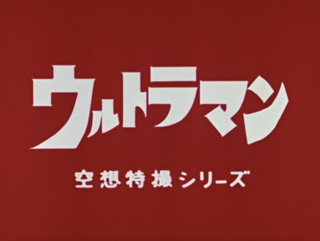
Ultraman is a Japanese tokusatsu science fiction television series created by Eiji Tsuburaya. Produced by Tsuburaya Productions, it is a follow-up to Ultra Q, though not technically a sequel or spin-off. Tsuburaya Productions produced 39 episodes that aired on Tokyo Broadcasting System (TBS) and its affiliate stations from July 17, 1966, to April 9, 1967. Its premiere topped the average rating set by Ultra Q and kept climbing each week, marking the show as a success. It was also the first Japanese television series to use a bidding system for commercial rights, allowing multiple third-party companies to sponsor the show. This was following TBS's merchandising troubles with its predecessor.
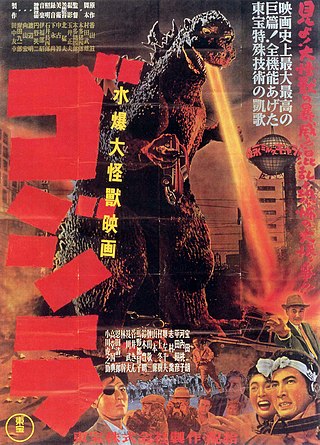
Tokusatsu is a Japanese term for live-action films or television programs that make heavy use of practical special effects. Credited to special effects director Eiji Tsuburaya, tokusatsu mainly refers to science fiction, war, fantasy, or horror media featuring such technology but is also occasionally dubbed a genre itself. Its contemporary use originated in the Japanese mass media around 1958 to explain special effects in an easy-to-understand manner and was popularized during the "first monster boom" (1966-1968). Prior to the monster boom, it was known in Japan as Tokushu gijutsu or shortened Tokugi.

Varan is a fictional monster, or kaiju, that first appeared in the 1958 film Varan the Unbelievable directed by Ishirō Honda and produced and distributed by Toho. Varan is depicted as a giant prehistoric reptile capable of gliding flight, and has gone on to appear in the 1968 film Destroy All Monsters, the ninth film in the Godzilla franchise.

Tsuburaya Productions is a Japanese special effects studio founded in 1963 by special effects director Eiji Tsuburaya and was run by his family, until October 2007, when the family sold the company to advertising agency TYO Inc. The studio is best known for producing the Ultra Series. Since 2007, the head office has been located in Hachimanyama, Setagaya, Tokyo.

The☆Ultraman is a Japanese animated television series co-produced by Tsuburaya Production and Tokyo Broadcasting System and animated by Sunrise. The series aired on TBS Television affiliates on the Wednesday 7:00 PM time slot from April 4, 1979 to March 26, 1980, lasting a total of 50 episodes. It was the eighth installment in the Ultra Series and began airing four years after the end of Ultraman Leo.

Ultraman: The Adventure Begins is a 1987 American-Japanese animated superhero film jointly produced by Hanna-Barbera Productions and Tsuburaya Productions and animated by both Studio Sign and Ashi Productions. It is the second foreign Ultra Series production overall, and the second foreign Ultraman film after The 6 Ultra Brothers vs. the Monster Army. Originally intended as a pilot for an animated series, no such series ever emerged and the pilot was made into a full-length film. It was broadcast on television in the United States on October 12, 1987, with a Japanese theatrical release following on April 28, 1989. The costumes based on the three main heroes were made for use in stage shows in Japan.
Ultraman Nice is a spin-off of the Ultra Series. Produced by Tsuburaya Productions, Ultraman Nice was released in a series of commercials on October 20, 1999, with a total of 20 episodes.
Ultraman Zoffy: Ultra Warriors vs. the Giant Monster Army is a 1984 Japanese kaiju superhero film produced by Tsuburaya Productions and directed by Kōichi Takano.

Ultraman: Monster Movie Feature is a 1967 Japanese superhero kaiju film directed by Hajime Tsuburaya, with special effects by Koichi Takano. Produced by Tsuburaya Productions and distributed by Toho Co., Ltd., it is the first film in the Ultraman franchise, consisting entirely of re-edited material from the original series. In the film, an extraterrestrial defends Earth from giant monsters who pose a threat to humanity.

Ultraman is a fictional superhero who debuted in the pilot episode to his 1966 TV series of the same name, entitled "The Birth of Ultraman". He is the first tokusatsu hero launched by the Ultra Series and by extension, Tsuburaya Productions. His appearance in the entertainment world helped spawn the Kyodai Hero genre with countless shows such as Godman and Iron King.
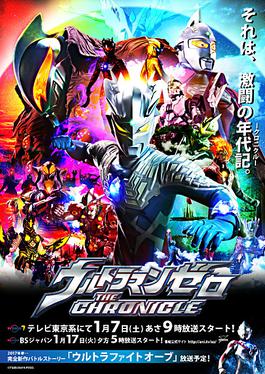
Ultraman Zero: The Chronicle is a biography series produced by Tsuburaya Productions created to commemorate the 50th anniversary of Ultra Seven. This show follows a format similar to Ultraman Retsuden, and continues to feature Ultraman Zero as the show's main navigator, bringing the viewers to movies and miniseries that featured his major involvement. Before its official airing in 2017 in Japan, it was shown in Malaysian television channel Astro Ceria starting from April 10, 2015 in Malay.
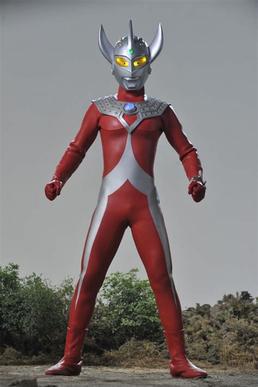
Ultraman Taro is the title character of the 1973 Ultra Series, Ultraman Taro. In the series, Ultraman Taro merged with Kotaro Higashi the latter loses his life during Astromons' rampage. After that, Kotaro joined the battle as a ZAT member and utilized Taro's power to fight against giant monsters while receiving assistance from either his fellow brothers-in-arms or his parents. In the final episode, Kotaro severed his connection to Taro and returned the Ultra Badge, as he wanted to continue living his life as a normal human. He is last seen traveling around the world.

Ultraman Jack is the protagonist of the 1971–1972 tokusatsu Ultra Series, Return of Ultraman. Sometime after Ultraseven's departure, Earth had entered a period of peace until a string of incidents wherein monsters awakened from slumber, appearing one after another. Jack bonded with the race car driver Hideki Go to save his life and as the former's means to operate on Earth while they joined MAT to fight against monster attacks and alien invasions.
Ultraman Z is a Japanese tokusatsu drama produced by Tsuburaya Productions. It is the 32nd entry to the Ultra Series and the eighth entry to the New Generation Hero lineup, celebrating the 10th anniversary of Ultraman Zero. It premiered in TV Tokyo on June 20, 2020. On April 2, 2023, an English dub was announced, with the premiere date of April 8 on the official Ultraman Youtube Channel, with new episodes uploaded every Saturday and Sundays at 11 pm JST.
Gomora is a fictional monster, or kaiju, that first appeared in episode 26 of Tsuburaya Productions' 1966 series Ultraman.

Eiji Tsuburaya (1901–1970) was a Japanese special effects director and filmmaker who worked on roughly 250 films throughout his five-decade career. Having pioneered and popularized the special effects sector of the Japanese film industry, he is popularly known as the "Father of Tokusatsu". Tsuburaya started his career in the Japanese film industry as a cinematographer for several successful dramas and jidaigeki films in the early 1920s. His directorial debut was the propaganda documentary film Three Thousand Miles Across the Equator, which he filmed in the Pacific Ocean on the Asama for most of 1935. Following the completion of photography on this film, he worked as the cinematographer and had his debut as special effects director on Princess Kaguya (1935). It was one of Japan's first major productions to feature special effects. The next year, Tsuburaya made his dramatic directorial debut with the release of Folk Song Collection: Oichi of Torioi Village and had substantial success staging the special effects for Arnold Fanck's The Daughter of the Samurai.
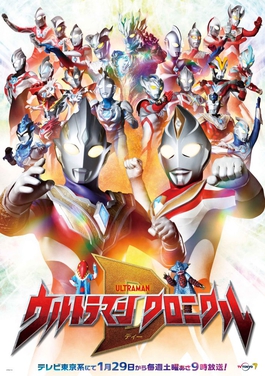
Ultraman Chronicle D is a biography series produced by Tsuburaya Productions created to commemorate the 25th anniversary of Ultraman Dyna. It features the main casts, Alien Metron "Marluru" of Ultraman Trigger: New Generation Tiga and Deban from Ultraman Tiga as navigators in an old house welcoming guests as they describe the past exploits of Ultraman Dyna and Ultraman Trigger in their respective shows.













